Mirco Ravanelli
FocalCodec: Low-Bitrate Speech Coding via Focal Modulation Networks
Feb 06, 2025Abstract:Large language models have revolutionized natural language processing through self-supervised pretraining on massive datasets. Inspired by this success, researchers have explored adapting these methods to speech by discretizing continuous audio into tokens using neural audio codecs. However, existing approaches face limitations, including high bitrates, the loss of either semantic or acoustic information, and the reliance on multi-codebook designs when trying to capture both, which increases architectural complexity for downstream tasks. To address these challenges, we introduce FocalCodec, an efficient low-bitrate codec based on focal modulation that utilizes a single binary codebook to compress speech between 0.16 and 0.65 kbps. FocalCodec delivers competitive performance in speech resynthesis and voice conversion at lower bitrates than the current state-of-the-art, while effectively handling multilingual speech and noisy environments. Evaluation on downstream tasks shows that FocalCodec successfully preserves sufficient semantic and acoustic information, while also being well-suited for generative modeling. Demo samples, code and checkpoints are available at https://lucadellalib.github.io/focalcodec-web/.
Adaptation Odyssey in LLMs: Why Does Additional Pretraining Sometimes Fail to Improve?
Oct 08, 2024



Abstract:In the last decade, the generalization and adaptation abilities of deep learning models were typically evaluated on fixed training and test distributions. Contrary to traditional deep learning, large language models (LLMs) are (i) even more overparameterized, (ii) trained on unlabeled text corpora curated from the Internet with minimal human intervention, and (iii) trained in an online fashion. These stark contrasts prevent researchers from transferring lessons learned on model generalization and adaptation in deep learning contexts to LLMs. To this end, our short paper introduces empirical observations that aim to shed light on further training of already pretrained language models. Specifically, we demonstrate that training a model on a text domain could degrade its perplexity on the test portion of the same domain. We observe with our subsequent analysis that the performance degradation is positively correlated with the similarity between the additional and the original pretraining dataset of the LLM. Our further token-level perplexity observations reveals that the perplexity degradation is due to a handful of tokens that are not informative about the domain. We hope these findings will guide us in determining when to adapt a model vs when to rely on its foundational capabilities.
Dynamic HumTrans: Humming Transcription Using CNNs and Dynamic Programming
Oct 07, 2024Abstract:We propose a novel approach for humming transcription that combines a CNN-based architecture with a dynamic programming-based post-processing algorithm, utilizing the recently introduced HumTrans dataset. We identify and address inherent problems with the offset and onset ground truth provided by the dataset, offering heuristics to improve these annotations, resulting in a dataset with precise annotations that will aid future research. Additionally, we compare the transcription accuracy of our method against several others, demonstrating state-of-the-art (SOTA) results. All our code and corrected dataset is available at https://github.com/shubham-gupta-30/humming_transcription
What Are They Doing? Joint Audio-Speech Co-Reasoning
Sep 22, 2024


Abstract:In audio and speech processing, tasks usually focus on either the audio or speech modality, even when both sounds and human speech are present in the same audio clip. Recent Auditory Large Language Models (ALLMs) have made it possible to process audio and speech simultaneously within a single model, leading to further considerations of joint audio-speech tasks. In this paper, we investigate how well ALLMs can perform joint audio-speech processing. Specifically, we introduce Joint Audio-Speech Co-Reasoning (JASCO), a novel task that unifies audio and speech processing, strictly requiring co-reasoning across both modalities. We release a scene-reasoning dataset called "What Are They Doing" and establish a joint audio-speech benchmark to evaluate the joint reasoning capability of popular ALLMs. Additionally, we provide deeper insights into the models' behaviors by analyzing their dependence on each modality.
LMAC-TD: Producing Time Domain Explanations for Audio Classifiers
Sep 13, 2024



Abstract:Neural networks are typically black-boxes that remain opaque with regards to their decision mechanisms. Several works in the literature have proposed post-hoc explanation methods to alleviate this issue. This paper proposes LMAC-TD, a post-hoc explanation method that trains a decoder to produce explanations directly in the time domain. This methodology builds upon the foundation of L-MAC, Listenable Maps for Audio Classifiers, a method that produces faithful and listenable explanations. We incorporate SepFormer, a popular transformer-based time-domain source separation architecture. We show through a user study that LMAC-TD significantly improves the audio quality of the produced explanations while not sacrificing from faithfulness.
ProGRes: Prompted Generative Rescoring on ASR n-Best
Aug 30, 2024Abstract:Large Language Models (LLMs) have shown their ability to improve the performance of speech recognizers by effectively rescoring the n-best hypotheses generated during the beam search process. However, the best way to exploit recent generative instruction-tuned LLMs for hypothesis rescoring is still unclear. This paper proposes a novel method that uses instruction-tuned LLMs to dynamically expand the n-best speech recognition hypotheses with new hypotheses generated through appropriately-prompted LLMs. Specifically, we introduce a new zero-shot method for ASR n-best rescoring, which combines confidence scores, LLM sequence scoring, and prompt-based hypothesis generation. We compare Llama-3-Instruct, GPT-3.5 Turbo, and GPT-4 Turbo as prompt-based generators with Llama-3 as sequence scorer LLM. We evaluated our approach using different speech recognizers and observed significant relative improvement in the word error rate (WER) ranging from 5% to 25%.
Open-Source Conversational AI with SpeechBrain 1.0
Jul 02, 2024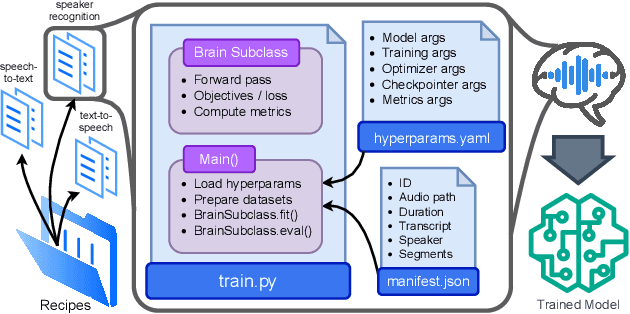

Abstract:SpeechBrain is an open-source Conversational AI toolkit based on PyTorch, focused particularly on speech processing tasks such as speech recognition, speech enhancement, speaker recognition, text-to-speech, and much more. It promotes transparency and replicability by releasing both the pre-trained models and the complete "recipes" of code and algorithms required for training them. This paper presents SpeechBrain 1.0, a significant milestone in the evolution of the toolkit, which now has over 200 recipes for speech, audio, and language processing tasks, and more than 100 models available on Hugging Face. SpeechBrain 1.0 introduces new technologies to support diverse learning modalities, Large Language Model (LLM) integration, and advanced decoding strategies, along with novel models, tasks, and modalities. It also includes a new benchmark repository, offering researchers a unified platform for evaluating models across diverse tasks
DASB -- Discrete Audio and Speech Benchmark
Jun 20, 2024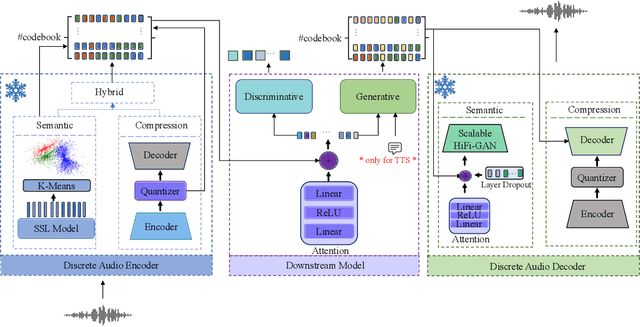
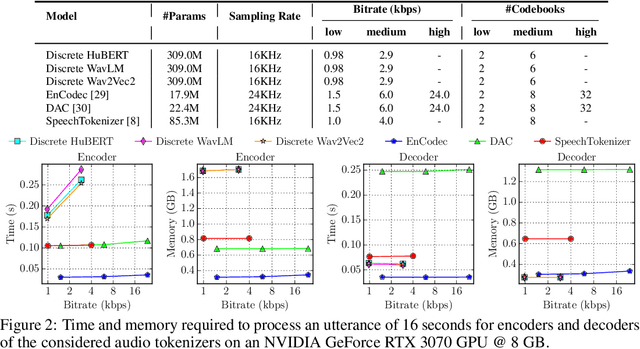
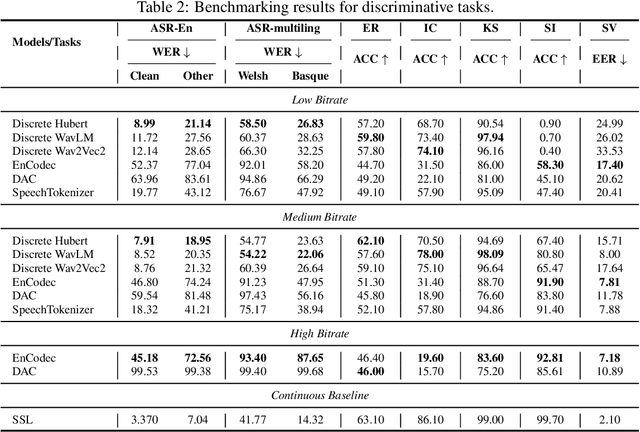
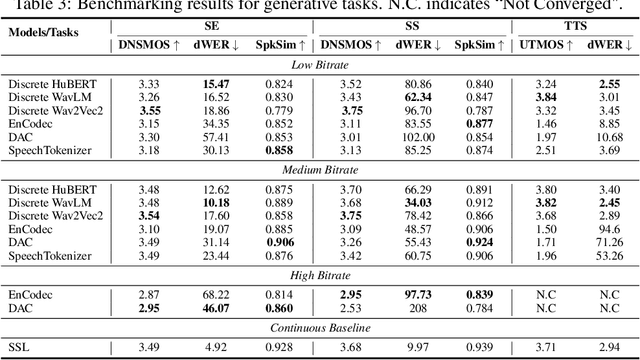
Abstract:Discrete audio tokens have recently gained considerable attention for their potential to connect audio and language processing, enabling the creation of modern multimodal large language models. Ideal audio tokens must effectively preserve phonetic and semantic content along with paralinguistic information, speaker identity, and other details. While several types of audio tokens have been recently proposed, identifying the optimal tokenizer for various tasks is challenging due to the inconsistent evaluation settings in existing studies. To address this gap, we release the Discrete Audio and Speech Benchmark (DASB), a comprehensive leaderboard for benchmarking discrete audio tokens across a wide range of discriminative tasks, including speech recognition, speaker identification and verification, emotion recognition, keyword spotting, and intent classification, as well as generative tasks such as speech enhancement, separation, and text-to-speech. Our results show that, on average, semantic tokens outperform compression tokens across most discriminative and generative tasks. However, the performance gap between semantic tokens and standard continuous representations remains substantial, highlighting the need for further research in this field.
How Should We Extract Discrete Audio Tokens from Self-Supervised Models?
Jun 15, 2024



Abstract:Discrete audio tokens have recently gained attention for their potential to bridge the gap between audio and language processing. Ideal audio tokens must preserve content, paralinguistic elements, speaker identity, and many other audio details. Current audio tokenization methods fall into two categories: Semantic tokens, acquired through quantization of Self-Supervised Learning (SSL) models, and Neural compression-based tokens (codecs). Although previous studies have benchmarked codec models to identify optimal configurations, the ideal setup for quantizing pretrained SSL models remains unclear. This paper explores the optimal configuration of semantic tokens across discriminative and generative tasks. We propose a scalable solution to train a universal vocoder across multiple SSL layers. Furthermore, an attention mechanism is employed to identify task-specific influential layers, enhancing the adaptability and performance of semantic tokens in diverse audio applications.
Phoneme Discretized Saliency Maps for Explainable Detection of AI-Generated Voice
Jun 14, 2024



Abstract:In this paper, we propose Phoneme Discretized Saliency Maps (PDSM), a discretization algorithm for saliency maps that takes advantage of phoneme boundaries for explainable detection of AI-generated voice. We experimentally show with two different Text-to-Speech systems (i.e., Tacotron2 and Fastspeech2) that the proposed algorithm produces saliency maps that result in more faithful explanations compared to standard posthoc explanation methods. Moreover, by associating the saliency maps to the phoneme representations, this methodology generates explanations that tend to be more understandable than standard saliency maps on magnitude spectrograms.
 Add to Chrome
Add to Chrome Add to Firefox
Add to Firefox Add to Edge
Add to Edge